Price-Response Matrices Design Methodology for Electrical Energy Management Systems Based on DC Bus Signalling
Abstract
1. Introduction
2. Price-Based Power Management
- (i)
- Regulator elements: can act controlling the dc bus voltage in a specific reference when it is necessary.
- (ii)
- Non-regulator elements: can be only connected or disconnected and cannot control the dc bus voltage.
- (i)
- Sources: supply positive power to the dc bus. Sources can operate in three possible operation modes: 0 (off), +1 (regulating dc bus), and +2 (not regulating dc bus voltage).
- (ii)
- Loads: demand power from the dc bus, defined as negative power. Loads can operate in three possible operation modes: 0 (off), −1 (regulating dc bus), and −2 (not regulating dc bus voltage).
- (iii)
- Bidirectional elements: may operate both as source or load. They can operate in all operation modes (−2, −1, 0, +1, +2). An example of a bidirectional element is the battery energy storage system (BESS). The utility grid also is a bidirectional element when the dc-ac converter can operate as a rectifier (source) or inverter (load to dc bus).
3. Price Response Matrices Determination Method
- (i)
- Definition of the fictitious price range, according to the real prices relevant to the power management.
- (ii)
- Definition of trigger prices for each element and their operation modes.
- (iii)
- Completion of the PRMs with other operation modes.
3.1. Fictitious Price Range Definition
- (i)
- The fictitious price $0 is defined as the real price 0 US$/kWh.
- (ii)
- When a fictitious price 0$ is the minimum selling price for renewable generator with production costs zero, it is necessary to include the fictitious price of $1 as a protection measure to allow all generators to turn off.
- (iii)
- Usually, different real prices are defined as different fictitious prices, but real prices can be grouped or split into different internal prices:
- Real price grouped: price groups are defined when certain situations never occur or are not relevant to power management. For example, in Figure 5, the battery cannot have low and intermediate SoC at the same time. So, one can group prices 0.9–2.0 US$/kWh into a single fictitious price without interfering with other power elements. Now, the fictitious price of $5 is the minimum selling value for both cases.
- Real price splitting: this situation can be defined when more than one regulator element is supposed to regulate the dc bus at the same real price. One real price can be split into more fictitious prices to avoid a power-sharing strategy. So, only one element regulates the dc bus voltage.
3.2. Definition of Price Response Matrices Dimensions
3.3. Trigger Price and Assignment of Operation Modes
- (i)
- Regulator elements: the numbers assigned inside the PRM at the TP are −1 (TPb—buying) or +1 (TPs—selling). When TPb and TPs are the same, number 11 is assigned.
- (ii)
- Non-regulator elements: the numbers assigned inside the PRM at the TPs are 0 (TPb—buying) or +8 (TPs—selling). When TPb and TPs are the same, number 0 is assigned.
4. Example of Price Response Matrices Applied in a DC Nanogrid
5. Experimental Results and Discussions
- Subfigure (a) shows dc bus voltage and the internal price signal, which was measured as an analog signal.
- Subfigure (b) shows PV generator power (Ppv), battery power (Pbat), and battery SoC.
- Subfigure (c) shows dc-ac converter power (Pgi), grid power (Pge), and total loads’ power (PL).
- Subfigure (d) shows the main ac side waveforms: ac voltage (vgi), dc-ac converter output current (igi), and the current injected into the grid (ige).
- Subfigure (e) shows the Power Management Algorithm’s main digital signals, including the internal price and the operation modes of all power elements.
- a.
- Scenario 1—Battery charging on the off-grid operation
- b.
- Scenario 2—Battery discharging on the off-grid operation
- c.
- Scenario 3—System initialization on the on-grid operation
- d.
- Scenario 4—Grid-tied operation with high SoC battery
6. Comparison with Other DC Bus Signaling Strategies
7. Conclusions
Supplementary Materials
Author Contributions
Funding
Institutional Review Board Statement
Informed Consent Statement
Data Availability Statement
Acknowledgments
Conflicts of Interest
References
- Kitamura, N.; Tanaka, K. Conceptual Study for Open Energy Systems: Distributed Energy Network Using Interconnected DC Nanogrids. IEEE Trans. Smart Grid 2015, 6, 1621–1630. [Google Scholar]
- IEC Low-Voltage Electrical Installations—Part 8-3: Functional Aspects—Operation of Prosumer’s Electrical Installations, IEC Standard 60364-8-2. 2018.
- Dafalla, Y.; Liu, B.; Hahn, D.A.; Wu, H.; Ahmadi, R.; Bardas, A.G. Prosumer Nanogrids: A Cybersecurity Assessment. IEEE Access 2020, 8, 131150–131164. [Google Scholar] [CrossRef]
- Kumar, D.; Zare, F.; Gosh, A. DC Microgrid Technology: System Architectures, AC Grid Interfaces, Grounding Schemes, Power Quality, Communication Networks, Applications, and Standardizations Aspects. IEEE Access 2016, 5, 12230–12256. [Google Scholar] [CrossRef]
- Faisal, M.; Hannan, M.A.; Ker, P.J.; Hussain, A.; Mansor, M.B.; Blaabjerg, F. Review of Energy Storage System Technologies in Microgrid Applications: Issues and Challenges. IEEE Access 2018, 6, 35143–35164. [Google Scholar] [CrossRef]
- Han, Y.; Li, H.; Shen, P.; Coelho, E.A.A.; Guerrero, J.M. Review of Active and Reactive Power Sharing Strategies in Hierarchical Controlled Microgrids. IEEE Trans. Power Electron. 2017, 32, 2427–2451. [Google Scholar] [CrossRef]
- Nejabatkhah, F.; Li, Y.W.; Tian, H. Power Quality Control of Smart Hybrid AC/DC Microgrids: An Overview. IEEE Access 2019, 7, 52295–52318. [Google Scholar] [CrossRef]
- Meng, L.; Shafiee, Q.; Trecate, G.F.; Karimi, H.; Fulwani, D.; Lu, X.; Guerrero, J.M. Review on Control of DC Microgrids and Multiple Clusters. IEEE J. Emerg. Sel. Topics Power Electron. 2017, 5, 928–948. [Google Scholar]
- Dutta, S.; Chatterjee, K. An AC-DC Hybrid Nanogrid System for PV and Battery Storage Based Futuristic Buildings. IEEE J. Emerg. Selec. Topics Ind. Electron. 2021. [Google Scholar] [CrossRef]
- Roncero-Clemente, C.; Gonzalez-Romera, E.; Barrero-González, F.; Milanés-Montero, M.I.; Romero-Cadaval, E. Power-Flow-Based Secondary Control for Autonomous Droop-Controlled AC Nanogrids with Peer-to-Peer Energy Trading. IEEE Access 2021, 9, 22339–22350. [Google Scholar] [CrossRef]
- Kumar, S.; Krishnasamy, V.; Kaur, R.; Kandasamy, N.K. Virtual Energy Storage-Based Energy Management Algorithm for Optimally Sized DC Nanogrid. IEEE Syst. J. 2021. [Google Scholar] [CrossRef]
- Skouros, I.; Karlis, A. A Study on the V2G Technology Incorporation in a DC Nanogrid and on the Provision of Voltage Regulation to the Power Grid. Energies 2020, 13, 2655. [Google Scholar] [CrossRef]
- Vazquez, A.; Martin, K.; Arias, M.; Sebastian, J. On Bidirectional DC Nano-Grids: Design Considerations and an Architecture Proposal. Energies 2019, 12, 3715. [Google Scholar] [CrossRef]
- Garrido-Zafra, J.; Moreno-Munoz, A.; Gil-de-Castro, A.; Palacios-Garcia, E.J.; Moreno-Moreno, C.D.; Morales-Leal, T. A Novel Direct Load Control Testbed for Smart Appliances. Energies 2019, 12, 3336. [Google Scholar] [CrossRef]
- González-Romera, E.; Ruiz-Cortés, M.; Milanés-Montero, M.-I.; Barrero-González, F.; Romero-Cadaval, E.; Lopes, R.A.; Martins, J. Advantages of Minimizing Energy Exchange Instead of Energy Cost in Prosumer Microgrids. Energies 2019, 12, 719. [Google Scholar] [CrossRef]
- Arbab-Zavar, B.; Palacios-Garcia, E.J.; Vasquez, J.C.; Guerrero, J.M. Smart Inverters for Microgrid Applications: A Review. Energies 2019, 12, 840. [Google Scholar] [CrossRef]
- Nömm, J.; Rönnberg, S.K.; Bollen, M.H.J. An Analysis of Voltage Quality in a Nanogrid during Islanded Operation. Energies 2019, 12, 614. [Google Scholar] [CrossRef]
- Zamora, R.; Srivastava, A.K. Multi-Layer Architecture for Voltage and Frequency Control in Networked Microgrids. IEEE Trans. Smart Grids 2019, 9, 2076–2085. [Google Scholar] [CrossRef]
- Andreotti, A.; Caiazzo, B.; Petrillo, A.; Santini, S.; Vaccaro, A. Hierarchical Two-Layer Distributed Control Architecture for Voltage Regulation in Multiple Microgrids in the Presence of Time-Varying Delays. Energies 2020, 13, 6507. [Google Scholar] [CrossRef]
- Nasir, M.; Jin, Z.; Khan, H.A.; Zaffar, N.A.; Vasquez, J.C.; Guerrero, J.M. A Decentralized Control Architecture Applied to DC Nanogrid Clusters for Rural Electrification in Developing Regions. IEEE Trans. Power Electron. 2019, 34, 1773–1785. [Google Scholar] [CrossRef]
- Li, F.; Lin, Z.; Qian, Z.; Wu, J.; Jiang, W. A Dual-Window DC Bus Interacting Method for DC Microgrids Hierarchical Control Scheme. IEEE Trans. Sustain. Energy 2020, 11, 652–661. [Google Scholar] [CrossRef]
- Burmester, D.; Rayudu, R.; Seah, W.; Akyinyele, D. A Review of Nanogrid Topologies and Technologies. Renew. Sustain. Energy Rev. 2017, 67, 760–775. [Google Scholar] [CrossRef]
- Babazadeh-Dizaji, R.; Hamzeh, M. Distributed Hierarchical Control for Optimal Power Dispatch in Multiple DC Microgrids. IEEE Syst. J. 2020, 14, 1015–1023. [Google Scholar] [CrossRef]
- Salvati, G.A.; Carati, E.G.; Cardoso, R.; da Costa, J.P.; Stein, C.M.O. Electric Vehicles Energy Management with V2G/G2V Multifactor Optimization of Smart Grids. Energies 2020, 13, 1–22. [Google Scholar] [CrossRef]
- Magni, C.; Arteconi, A.; Kavvadias, K.; Quoilin, S. Modelling the Integration of Residential Heat Demand and Demand Response in Power Systems with High Shares of Renewables. Energies 2020, 13, 6628. [Google Scholar] [CrossRef]
- Kajanova, M.; Bracinik, P.; Roch, M. Utilization of finite state machine approach for microgrid modeling. Electr. Eng. 2020, 102, 53–63. [Google Scholar] [CrossRef]
- Kaviri, S.M.; Hajebrahimi, H.; Poorali, B.; Pahlevani, M.; Jain, P.K.; Bakhshai, A. A Supervisory Control System for Nanogrids Operating in the Stand-Alone Mode. IEEE Trans. Power Electron. 2021, 36, 2914–2931. [Google Scholar] [CrossRef]
- Dragičević, T.; Guerrero, J.M.; Vasquez, J.C.; Škrlec, D. Supervisory Control of an Adaptive-Droop Regulated DC Microgrid With Battery Management Capability. IEEE Trans. Power Electron. 2014, 29, 695–706. [Google Scholar] [CrossRef]
- Schwertner, C.D.; Bellinaso, L.V.; Hey, H.L.; Michels, L. Supervisory Control for Stand-Alone Photovoltaic Systems. In Proceedings of the IEEE 12th Brazilian Power Electronics Conference 2013, Gramado, Brazil, 27–31 October 2013. [Google Scholar]
- Bellinaso, L.V.; Schwertner, C.D.; Michels, L. Price-Based Power Management of off-grid Photovoltaic Systems with Centralised DC Bus. IET Renew. Power Gener. 2016, 10, 1132–1139. [Google Scholar] [CrossRef]
- Schonbergerschonberger, J.; Duke, R.; Round, S.D. DC-Bus Signaling: A Distributed Control Strategy for a Hybrid Renewable Nanogrid. IEEE Trans. Ind. Electron. 2006, 53, 1453–1460. [Google Scholar] [CrossRef]
- Fan, B.; Guo, S.; Peng, J.; Yang, Q.; Liu, W.; Liu, L. A Consensus-Based Algorithm for Power Sharing and Voltage Regulation in DC Microgrids. IEEE Trans. Ind. Inform. 2020, 16, 3987–3996. [Google Scholar] [CrossRef]
- Sun, K.; Zhang, L.; Xing, Y.; Guerrero, J.M. A Distributed Control Strategy Based on DC Bus Signaling for Modular Photovoltaic Generation Systems with Battery Energy Storage. IEEE Trans. Power Electron. 2011, 26, 3032–3045. [Google Scholar] [CrossRef]
- Wu, D.; Tang, F.; Dragicevic, T.; Guerrero, J.M.; Vasquez, J.C. Coordinated Control Based on Bus-Signaling and Virtual Inertia for Islanded DC Microgrids. IEEE Trans. Smart Grid 2015, 6, 2627–2638. [Google Scholar] [CrossRef]
- Nguyen, T.L.; Guerrero, J.M.; Griepentrog, G. A Self-Sustained and Flexible Control Strategy for Islanded DC Nanogrids Without Communication Links. IEEE J. Emerg. Sel. Top. Power Electron. 2020, 8, 877–892. [Google Scholar] [CrossRef]
- Sandgani, M.R.; Sirouspour, S. Energy Management in a Network of Grid-Connected Microgrids/Nanogrids Using Compromise Programing. IEEE Trans. Smart Grid 2018, 9, 2180–2191. [Google Scholar]
- Dehghanpour, K.; Nehrir, H. An Agent-Based Hierarchical Bargaining Framework for Power Management of Multiple Cooperative Microgrids. IEEE Trans. Smart Grid 2019, 10, 512–514. [Google Scholar] [CrossRef]
- Papari, B.; Edrigton, C.S.; Bhattacharya, I.; Radman, G. Effective Energy Management of Hybrid AC–DC Microgrids with Storage Devices. IEEE Trans. Smart Grid 2019, 10, 93–203. [Google Scholar] [CrossRef]
- Carvalho, E.L.; Meneghetti, L.H.; Carati, E.G.; Costa, J.P.D.; Stein, C.M.D.O.; Cardoso, R. Asymmetrical Pulse-Width Modulation Strategy for Current-Fed Dual Active Bridge Bidirectional Isolated Converter Applied to Energy Storage Systems. Energies 2020, 13, 3475. [Google Scholar] [CrossRef]
- Deotti, L.; Guedes, W.; Dias, B.; Soares, T. Technical and Economic Analysis of Battery Storage for Residential Solar Photovoltaic Systems in the Brazilian Regulatory Context. Energies 2020, 13, 6517. [Google Scholar] [CrossRef]
- Haroun, R.; El Aroudi, A.; Cid-Pastor, A.; Vidal-Idiarte, E.; Valderrama-Blavi, H.; Martinez-Salamero, L. Modelling and Control of Modular DC-Nanogrids Based on Loss-Free Resistors. IEEE Access 2020, 8, 33305–33317. [Google Scholar] [CrossRef]
- Yoomak, S.; Ngaopitakkul, A. Development of Sustainable Nanogrid Road Lighting Systems. IEEE Trans. Intell. Transp. Syst. 2021. [Google Scholar] [CrossRef]

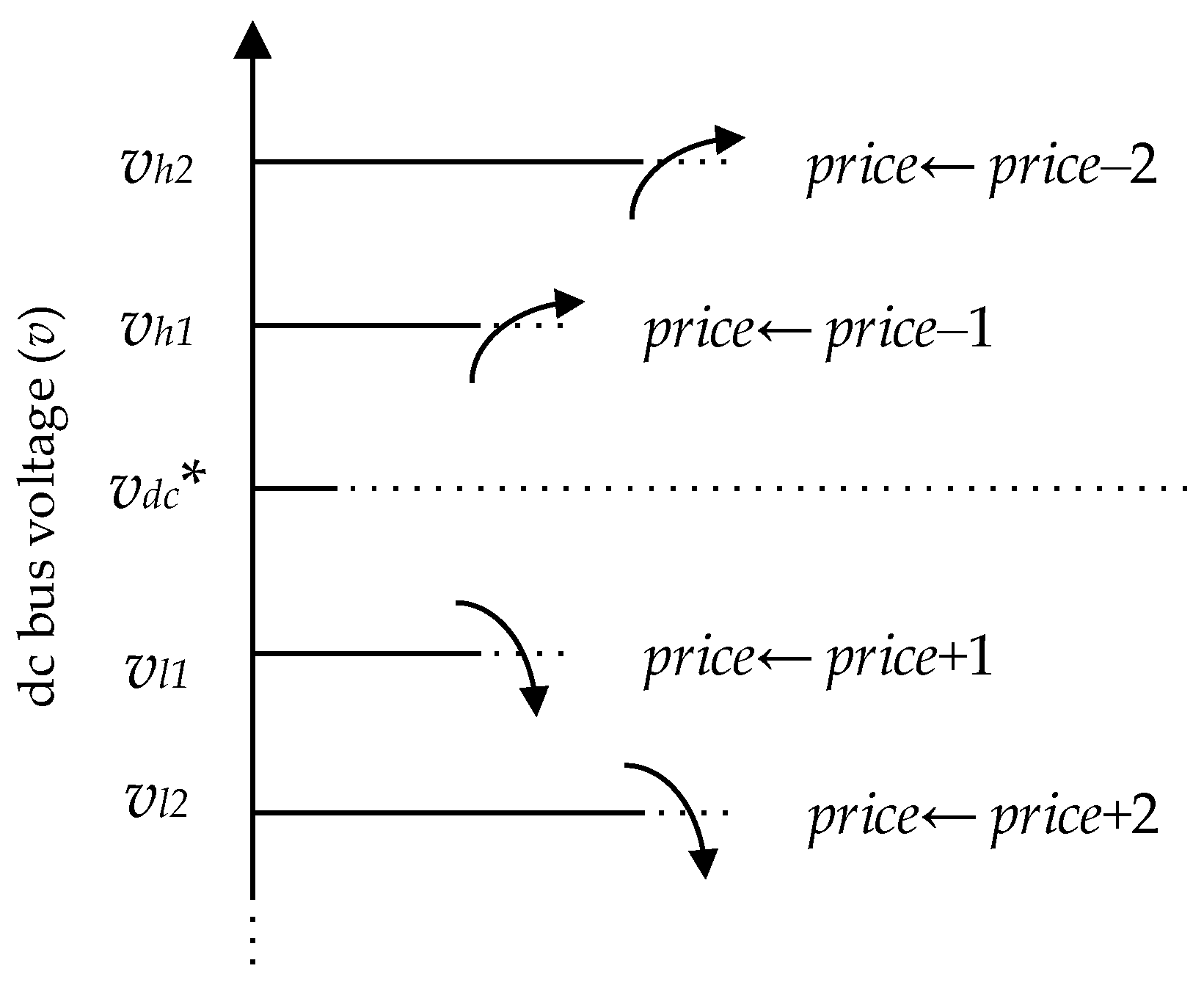
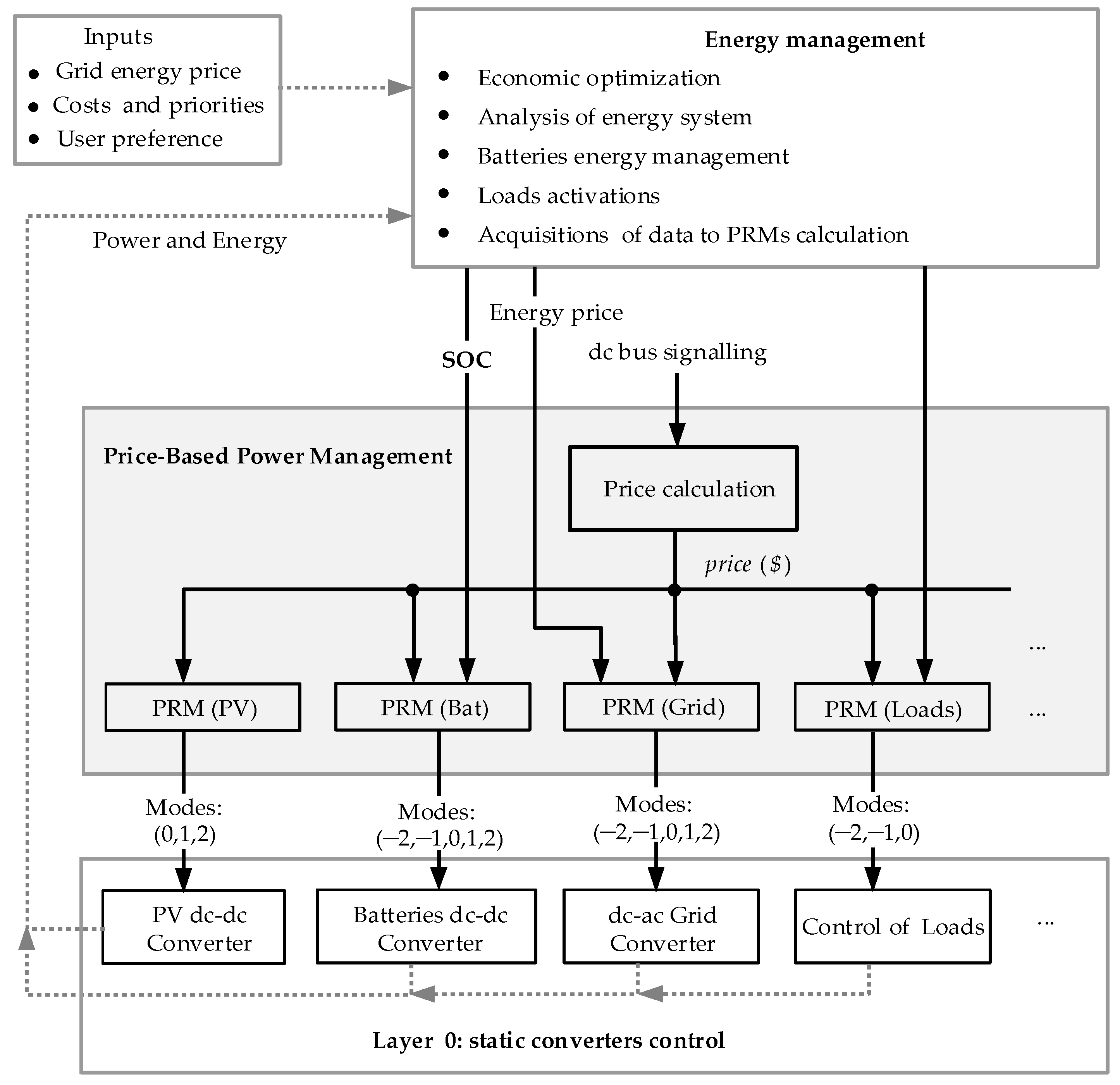
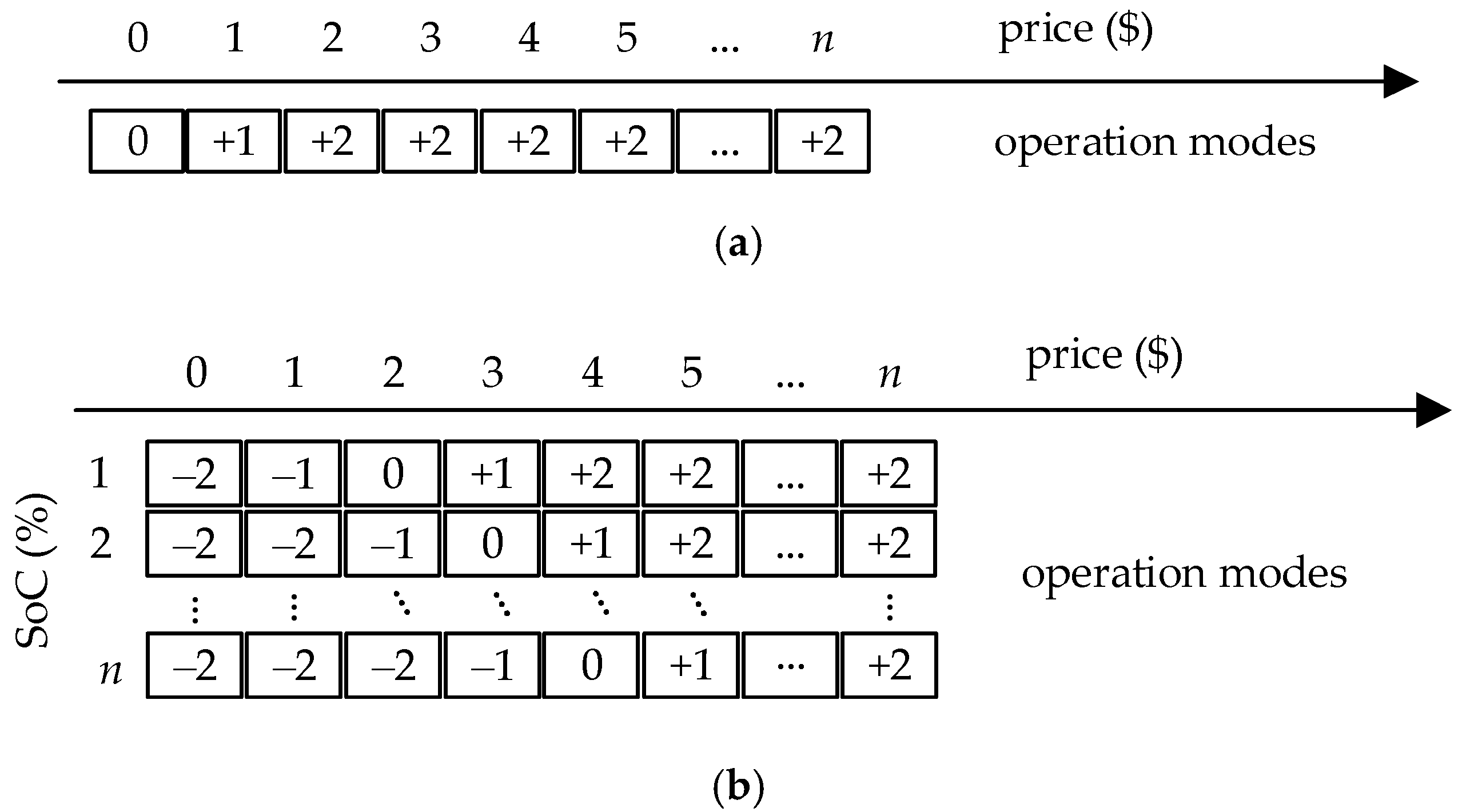
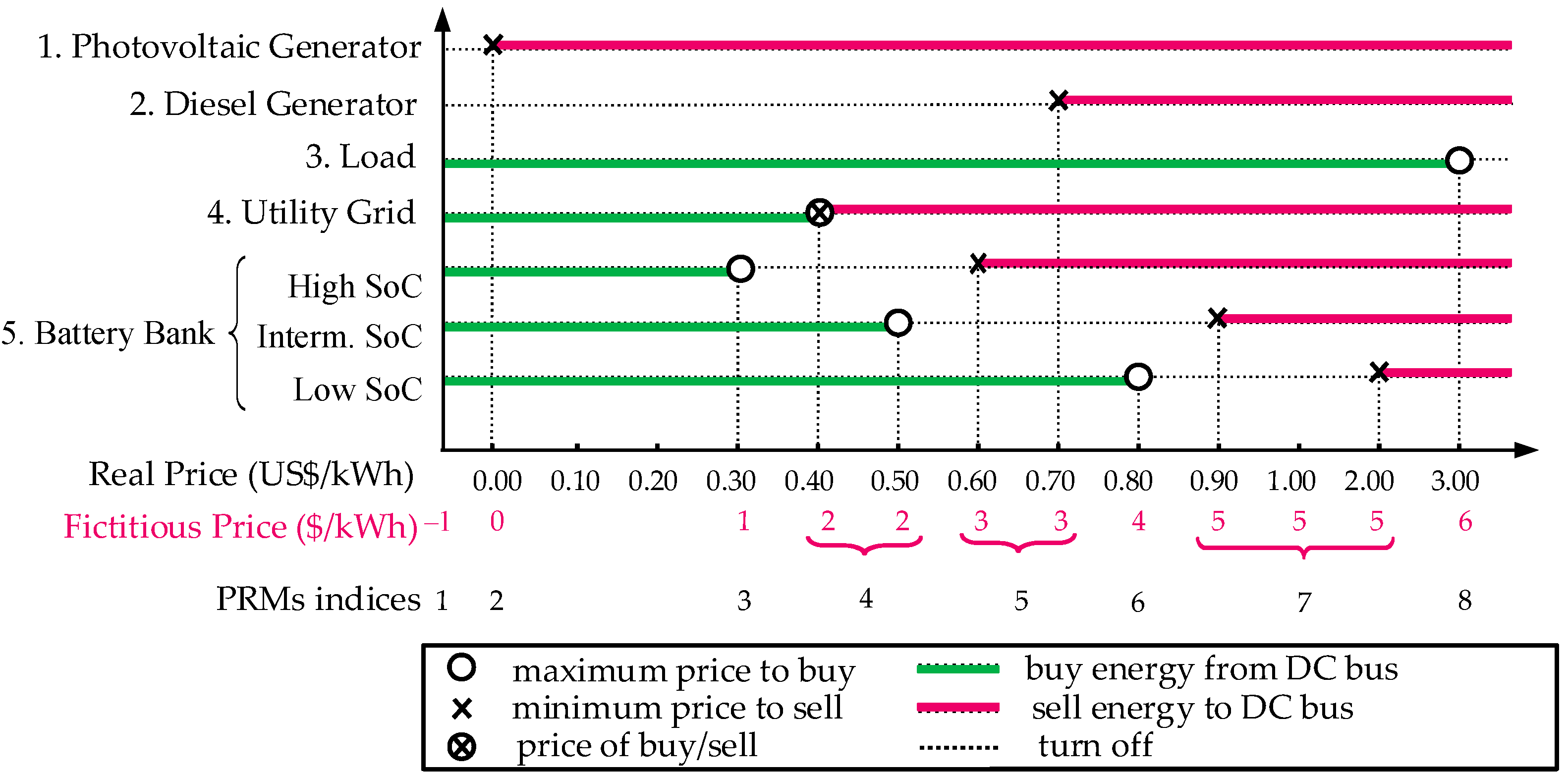
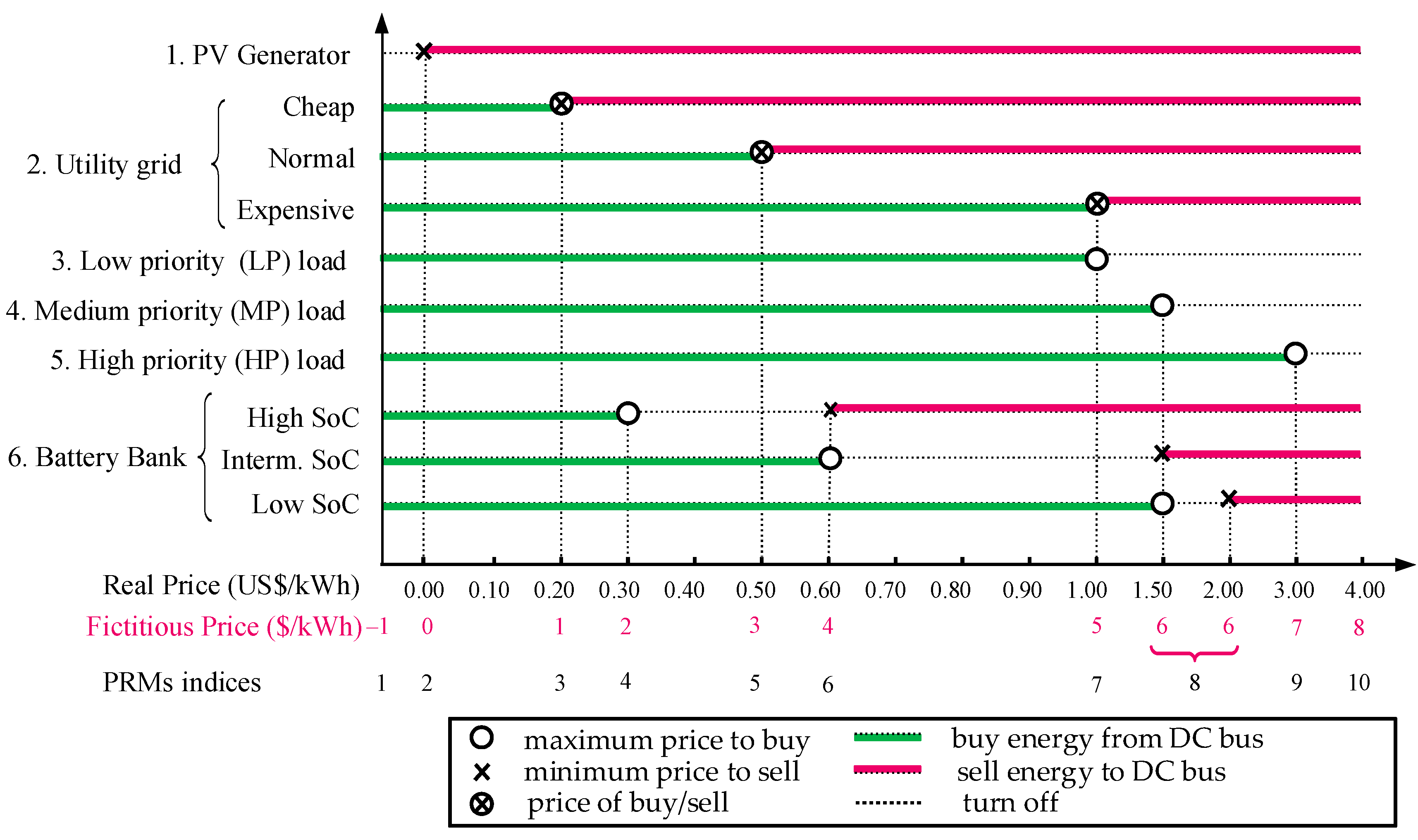
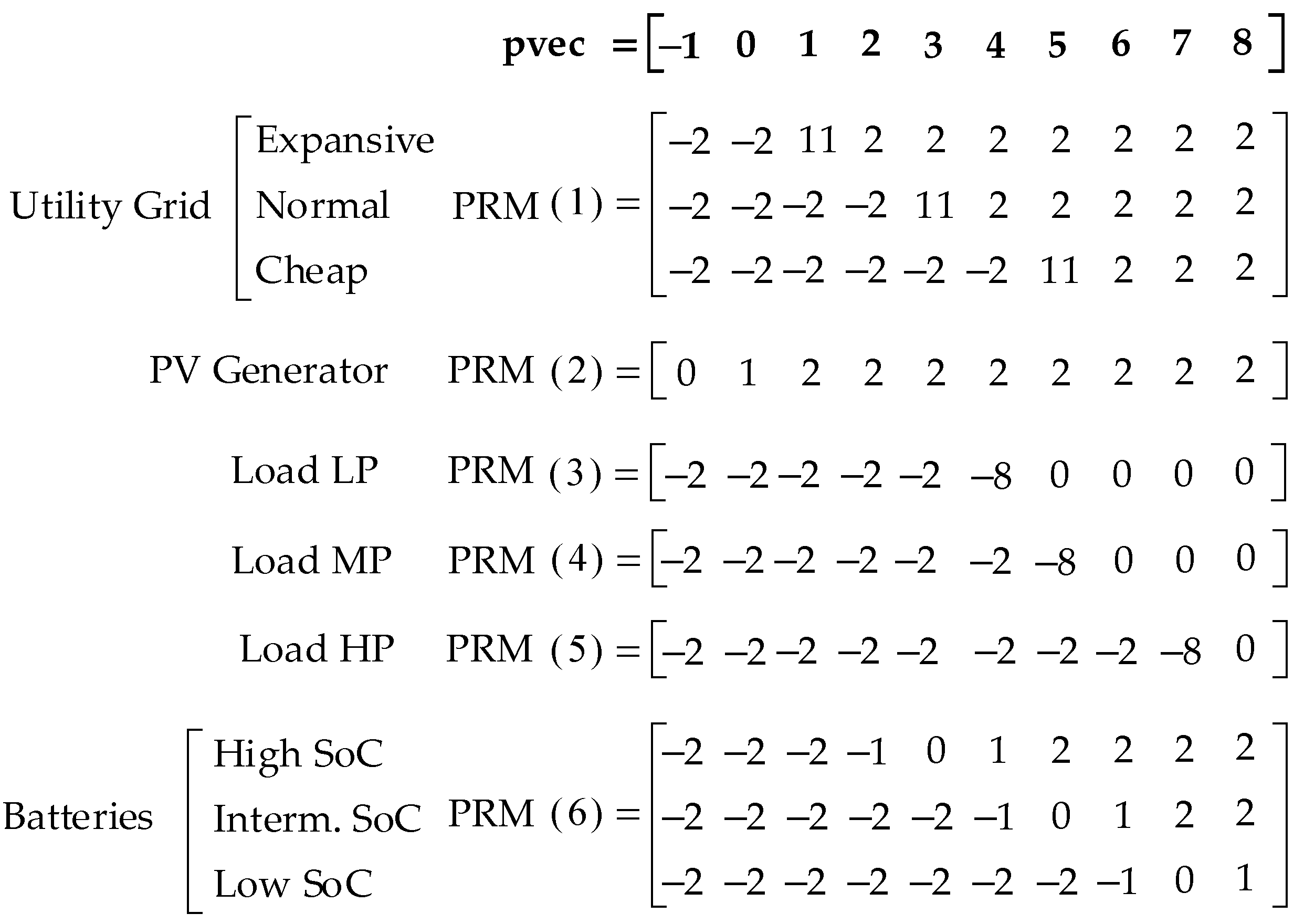

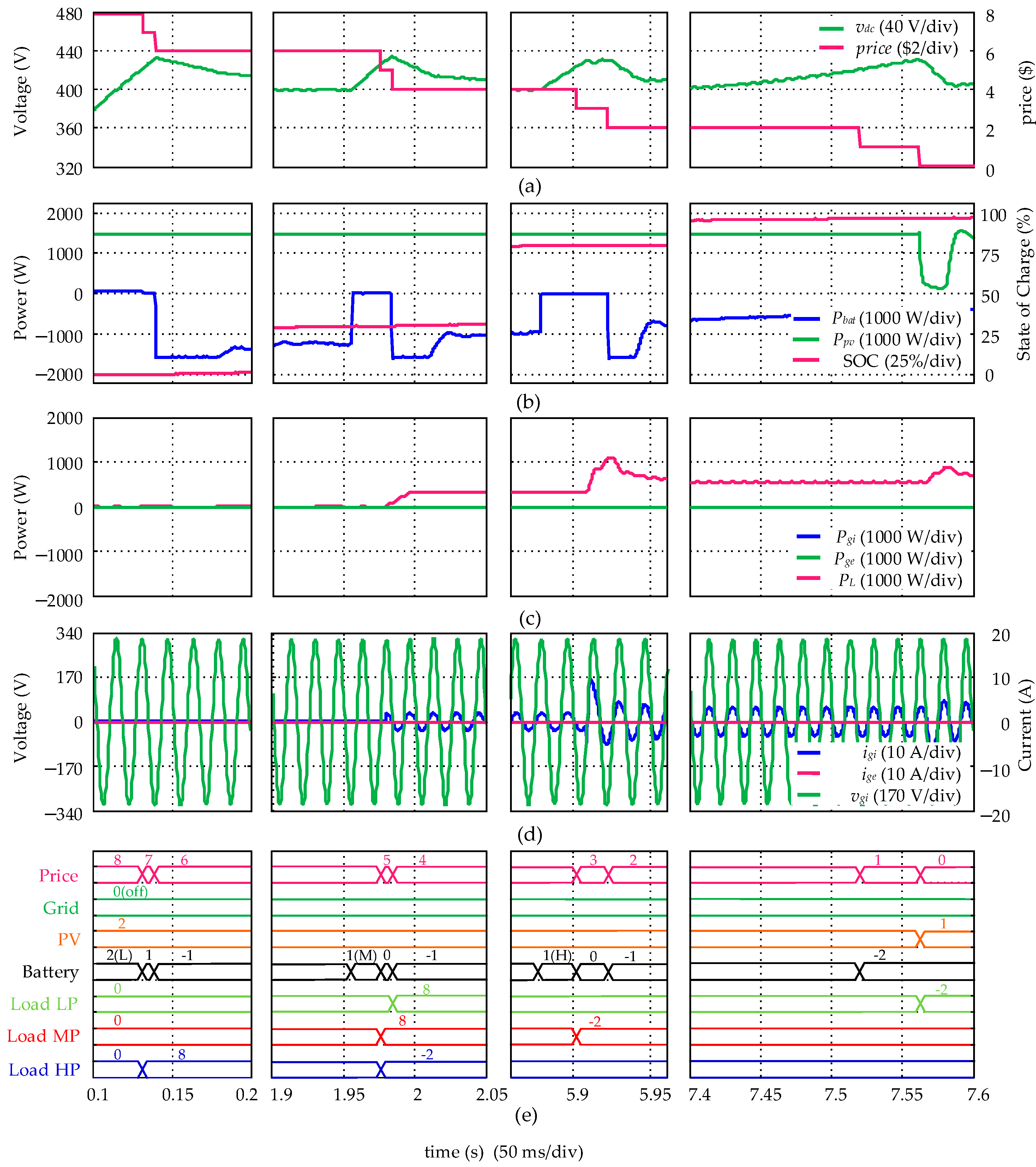
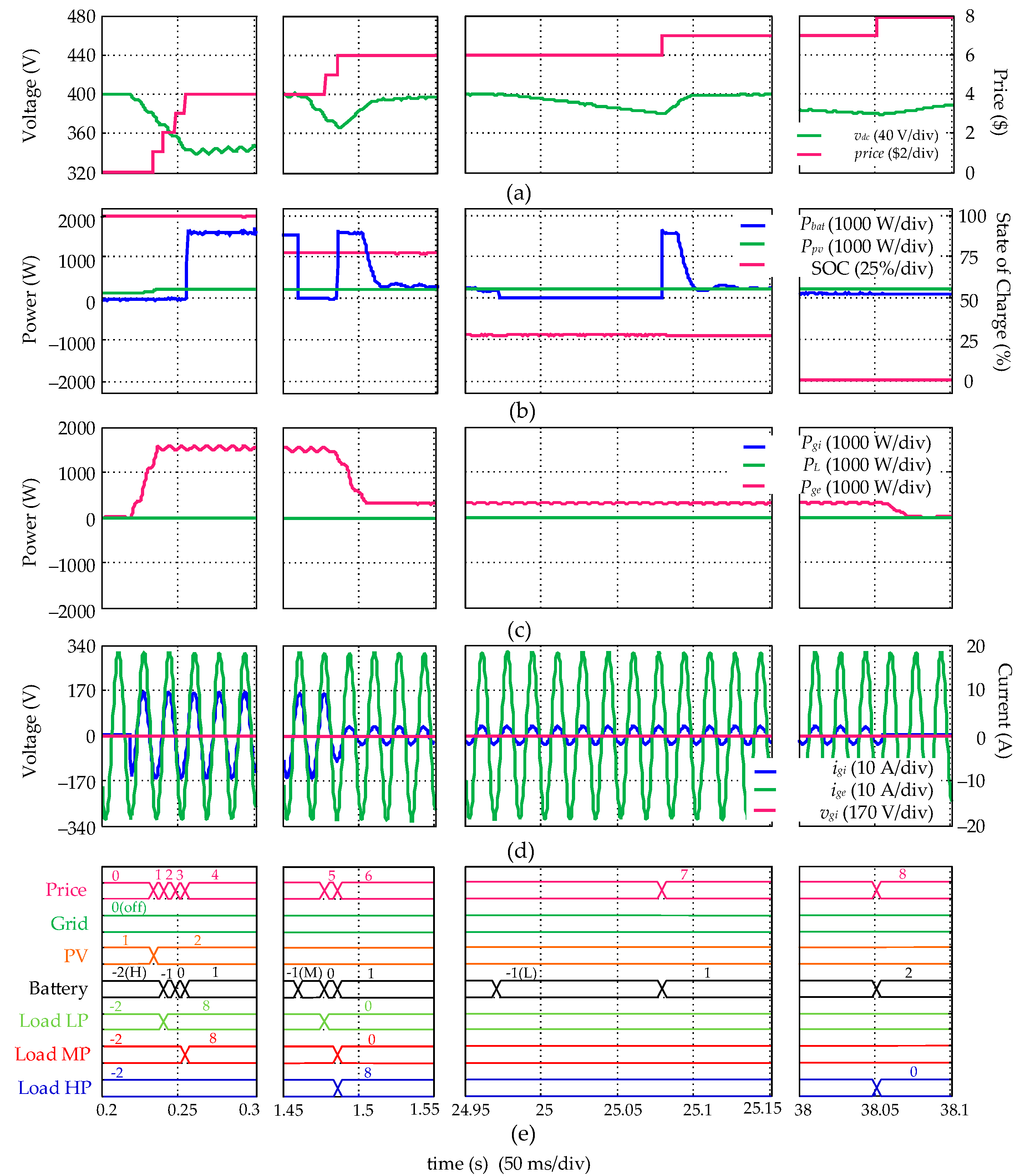
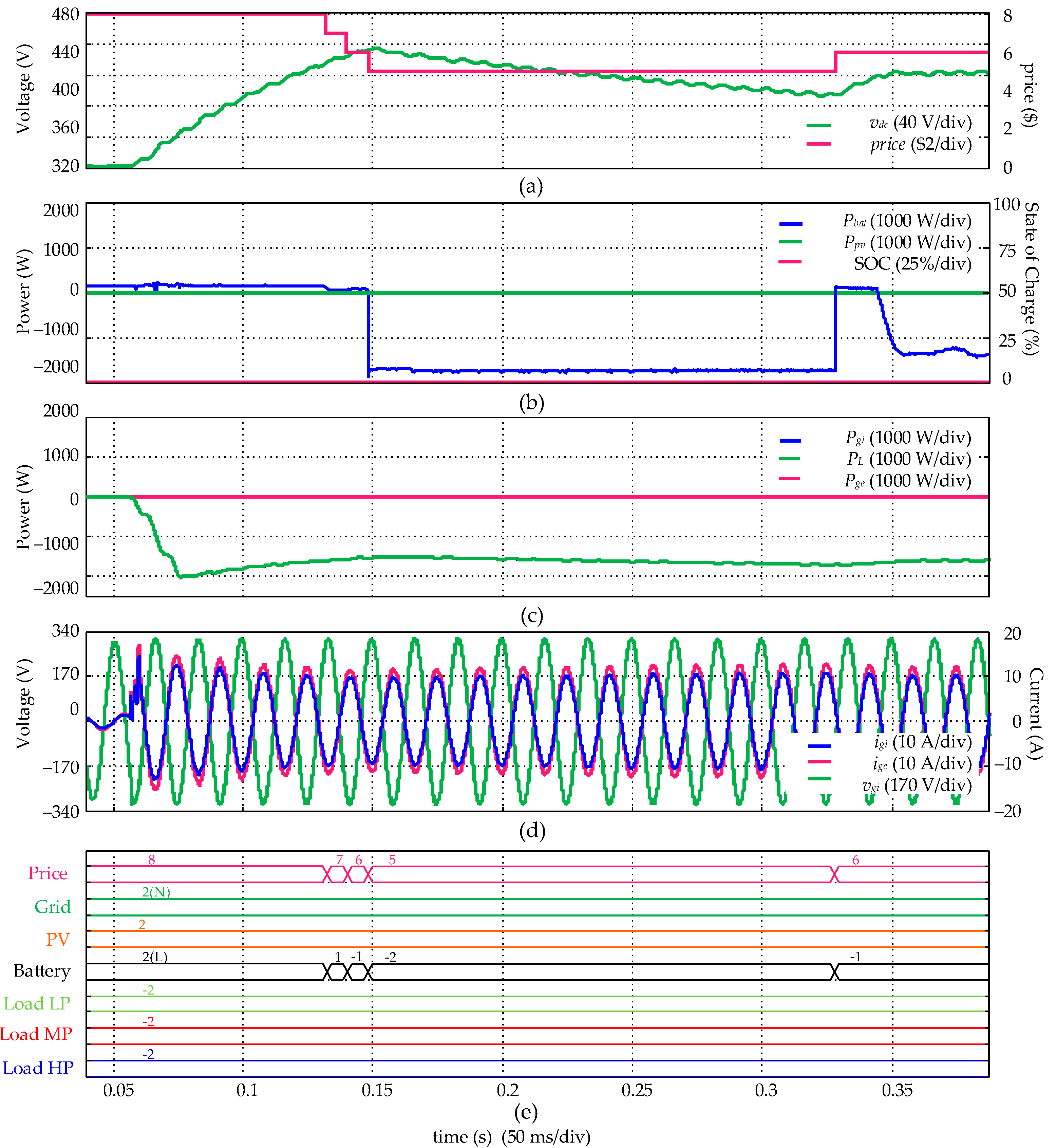
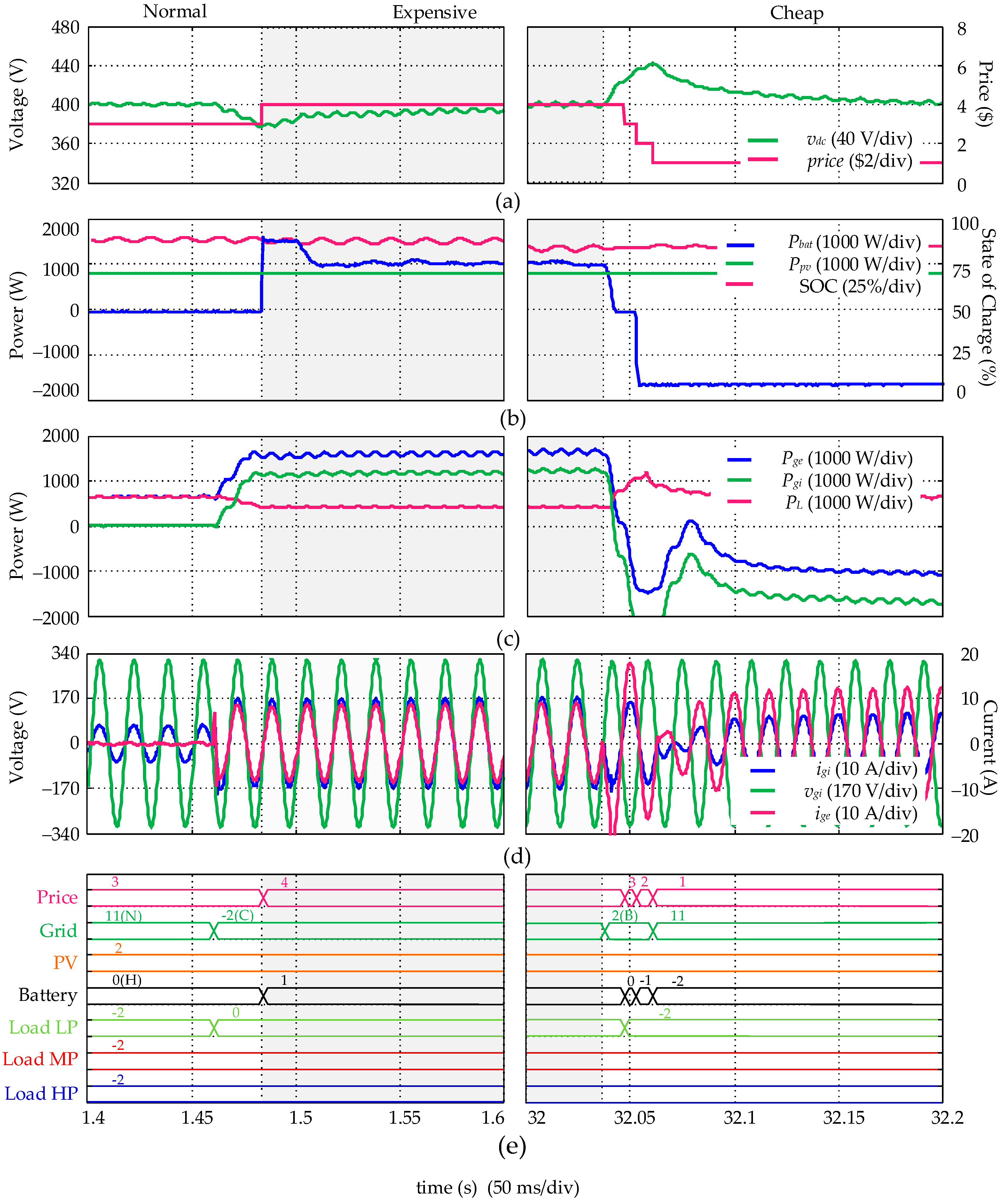
| Power Element | Power Flow | DCBVR Type | Operation Mode |
|---|---|---|---|
| LED lighting | Load | Non-Regulator | 0 (off)/−2 (on) |
| Air conditioners | Load | Regulator | 0 (off)/−1 (DCBVR)/−2(NC *) |
| Electronic loads (TV sets, modems, computers, etc.) | Load | Non-Regulator | 0 (off)/−2 (on) |
| PV Generator | Source | Regulator | 0 (off)/+1 (DCBVR) +2 (MPPT) |
| Battery bank | Bidirectional | Regulator | −2 (Charging NC)/−1 (DCBVR)/0 (off)/+1 (DCBVR) +2 (Discharging NC) |
| Utility grid (dc-ac converter) | Bidirectional | Regulator | −2 (Inverter NC)/−1 (DCBVR)/0 (off)/+1 (DCBVR) +2 (Rectifier NC) |
| Supercapacitor | Bidirectional | Non-Regulator | 0 (off)/+2 (on) |
| Diesel generator | Source | Regulator | 0 (off)/+1 (DCBVR)/+2(NC) |
| Price Related to PRM Column | Buying | Selling | |||||
|---|---|---|---|---|---|---|---|
| <TPb | TPb | ≥TPb | ≤TPs | TPs | >TPs | ||
| Regulator | Load | −2 | −1 | 0 | - | - | - |
| Source | - | - | - | 0 | +1 | +2 | |
| Bidirectional | −2 | −1 | 0 | 0 | +1 | +2 | |
| Bidirectional (TPb = TPs) | −2 | 11 | 11 | 11 | 11 | +2 | |
| Non-Regulator | Load | −2 | −8 | 0 | 0 | - | - |
| Source | - | - | 0 | 0 | +8 | +8 | |
| Bidirectional | −8 | 0 | 0 | 0 | +8 | +8 | |
| Bidirectional (TPb = TPs) | −8 | 0 | 0 | 0 | 0 | +8 | |
| Power Element | Power Flow | DCBVR Type * | Number of OCs |
|---|---|---|---|
| (1) Utility Grid | Bidirectional | Regulator | 3 |
| (2) PV Generator | Source | Regulator | 1 |
| (3) Load LP | Load | Non-Regulator | 1 |
| (4) Load MP | Load | Non-Regulator | 1 |
| (5) Load HP | Load | Non-Regulator | 1 |
| (6) Batteries | Bidirectional | Regulator | 3 |
| Parameter | Description | Value |
|---|---|---|
| dc bus | ||
| Cdc | dc bus capacitance | 2.5 mF |
| vdc* | dc bus voltage reference | 400 V |
| fs | Switching frequency of all power converters | 24 kHz |
| PV converter parameters | ||
| Ppv | PV maximum power | 1.5 kW |
| ipv,max | PV maximum current | 8 A |
| Cpv | PV converter input capacitor | 100 µF |
| Lpv | PV converter inductor | 1.5 mH |
| Bidirectional dc-dc converter | ||
| Pbat | Battery bank nominal power | 1.5 kW |
| ibat | Battery nominal current | 8 A |
| vbat | Battery bank nominal voltage | 190 V |
| Lb1 | Bidirectional converter inductor | 1.5 mH |
| Lb2 | Bidirectional converter inductor | 15 µH |
| Cb | Bidirectional converter capacitor | 100 µF |
| dc-ac converter parameters | ||
| Pac | dc-ac converter nominal power | 2.0 kW |
| vg | dc-ac converter output voltage | 220 Vrms |
| fg | ac grid frequency | 60 Hz |
| Li1 | dc-ac converter inductor | 400 µH |
| Li2 | dc-ac converter inductor | 15 µH |
| Ci | dc-ac converter capacitor | 5 µF |
| Loads | ||
| HP | High priority load | 300 W |
| MP | Medium priority load | 600 W |
| LP | Low priority load | 600 W |
| Parameter | Description | Value |
|---|---|---|
| fsv | Sample frequency of voltage loops | 2.4 kHz |
| fsi | Sample frequency of current loops | 24 kHz |
| fmppt | Sample frequency of MPPT | 2.4 Hz |
| fcv | Cut-off frequency of voltage loops | 24 Hz |
| fci | Cut-off frequency of current loops | 240 Hz |
| PM | Minimum phase margin of controllers | 80° |
| High comparison | vh1 | vh2 | vh3 | vh4 | vh5 | vh6 | vh7 | vh8 |
| Voltage (V) | 420 | 430 | 439 | 448 | 457 | 466 | 475 | 484 |
| Low comparison | vl1 | vl2 | vl3 | vl4 | vl5 | vl6 | vl7 | vl8 |
| Voltage (V) | 380 | 370 | 359 | 348 | 337 | 326 | 314 | 302 |
| Parameters | Price Based DBS [30] | Hierarchical Droop Contol [21] | Optimal State Machine [29] | Proposed PRMs |
|---|---|---|---|---|
| Compassion voltages levels | 8 | 4 | 8 | 16 |
| DCBVR * | High performance | Low performance | High performance | High performance |
| Number of power elements | 4 (only off-grid operation) | 4 | 4 (only off-grid operation) | 6 |
| Control specifications | Needs an accurate and fast voltage detection | Results in high-frequency variation in the dc bus voltage | An off-line optimization is needed to reduce the state machine | Only the user preferences are needed to design the PRMs |
| Communication links | High bandwidth | - | High bandwidth | High bandwidth |
| Transmitted variables | Only the internal price | - | vdc and converter power levels | Only the internal price |
| Degrees of modularity | Intermediate (no methodology to define the operation modes) | Intermediate (master-slave control is needed) | Low (the system must be redesign to add new power elements) | High (only the PRMs must be increases to add new elements) |
Publisher’s Note: MDPI stays neutral with regard to jurisdictional claims in published maps and institutional affiliations. |
© 2021 by the authors. Licensee MDPI, Basel, Switzerland. This article is an open access article distributed under the terms and conditions of the Creative Commons Attribution (CC BY) license (http://creativecommons.org/licenses/by/4.0/).
Share and Cite
Bellinaso, L.V.; Carvalho, E.L.; Cardoso, R.; Michels, L. Price-Response Matrices Design Methodology for Electrical Energy Management Systems Based on DC Bus Signalling. Energies 2021, 14, 1787. https://doi.org/10.3390/en14061787
Bellinaso LV, Carvalho EL, Cardoso R, Michels L. Price-Response Matrices Design Methodology for Electrical Energy Management Systems Based on DC Bus Signalling. Energies. 2021; 14(6):1787. https://doi.org/10.3390/en14061787
Chicago/Turabian StyleBellinaso, Lucas V., Edivan L. Carvalho, Rafael Cardoso, and Leandro Michels. 2021. "Price-Response Matrices Design Methodology for Electrical Energy Management Systems Based on DC Bus Signalling" Energies 14, no. 6: 1787. https://doi.org/10.3390/en14061787
APA StyleBellinaso, L. V., Carvalho, E. L., Cardoso, R., & Michels, L. (2021). Price-Response Matrices Design Methodology for Electrical Energy Management Systems Based on DC Bus Signalling. Energies, 14(6), 1787. https://doi.org/10.3390/en14061787








